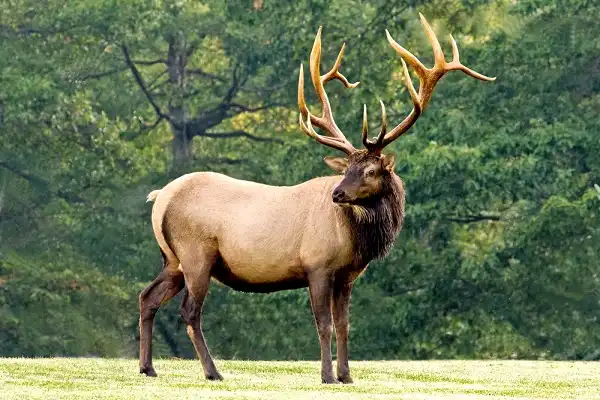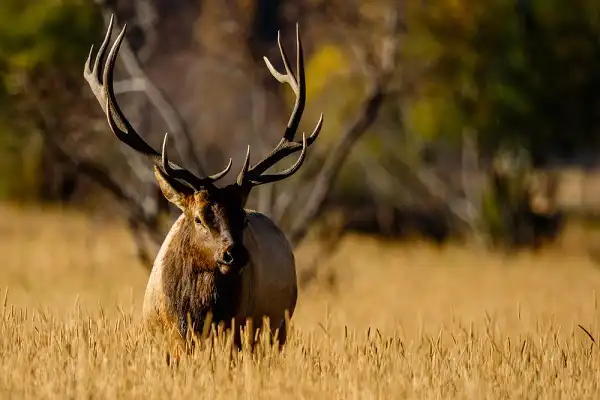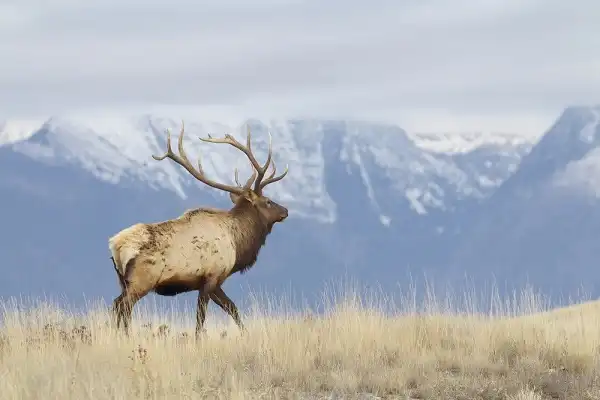Encountering an elk in the wild can be both a beautiful and majestic experience. Whether it’s during the fall mating season or while casually strolling through your backyard, learning more about these creatures can help us form a deeper connection with them and become better stewards of their environment. In this blog post, we’ll dive into some fascinating facts about elks’ anatomy and behavior—as well as how you can spot them around your home—so that you too can appreciate these incredible animals!

Elk Description
The elk, also known as the wapiti, is a majestic and beautiful species of hoofed mammal native to North America. They are stoutly built with a large head, a thick neck, and short legs. The fur on their bodies is typically brown in color and is made up of both long guard hairs (which provide insulation) and shorter underfur (which helps keep them warm). Additionally, male elks possess antlers that grow from their heads each year during springtime.
Elk Habitat
Elk are most commonly seen in open foraging spaces and forest habitats, but they have adapted to many different ecosystems across North America. They can be found roaming through meadows, parks, and even mountainous regions. As a result of their wide range of habitat preferences, elk can be commonly sighted in places like the Rocky Mountains of Colorado or the rolling hills of Pennsylvania. In addition to providing food sources for elk, these habitats also supply them with shelter and water. During the summer months when temperatures rise, elk seek out high-elevation mountain meadows where snowmelt can provide them with cool drinking water. In the winter months when it’s colder, elk descend to lower-elevation forests where they can take shelter under thick tree coverings from extreme weather conditions.
Elks are highly adaptable creatures that have evolved to thrive in various climates and topographies across North America—from the dry deserts of Arizona to the lush rainforests of British Columbia. With their sensitive sense of smell and hearing, elks are able to quickly detect any predators that may lurk nearby so that they can protect themselves in their chosen habitat.
Elk Diet
Elk are herbivores and their diet is mainly composed of grasses, shrubs, and other plant matter. They feed voraciously on these vegetation sources to build up fat reserves that will help them survive the colder winter months. Elk also forage in forests but usually much less often than in open meadows since they prefer to stay out of the shadows where predators lurk. In addition to grasses and shrubs, elks also feed on a variety of fruits such as apples or cherries as well as nuts like acorns and hazelnuts when available. During winter months when food sources become scarce, they may turn to trees and bark for sustenance.
Even though elk have adapted to eating various plant-based foods, they generally prefer specific types of plants such as willow shoots over others with higher protein content. Elks’ diets vary from region to region depending on the availability of food sources in their habitats—for example, Rocky Mountain elk are more likely to eat willow shoots due to the plentiful presence of this plant there compared with Eastern elk who might eat oak or hickory nuts instead as these trees are more abundant there. As omnivorous creatures, elks also occasionally scavenge carcasses left behind by predators which can provide them with an additional source of nutrition.

Elk Size
Elk are the largest species of deer in North America, and depending on their gender and age, they can reach a weight of up to 700 pounds. Male elks (also known as bulls) stand much taller than their female counterparts (also known as cows) with some bulls reaching heights of over 5 feet. Both males and females have antlers that start to form in late spring and grow rapidly during summer before being shed each year before winter starts. In addition to their size differences, bull elks typically have darker fur than cows while both genders usually sport a lighter-colored rump patch. The most prominent feature of an elk is its long curved antlers which can measure up to 5 feet wide at the base. These impressive structures are used primarily for fighting off predators and competing with other males during the mating season for dominance within a herd.
Elk Lifespan
Elk typically have an expected lifespan of around 15-20 years in the wild. However, some elks that live in protected areas such as national parks can reach up to 25 or even 30 years since they are not subject to hunting or other predators. In addition, bulls tend to have shorter lifespans than cows due to the strain of their larger body mass and more intense bouts of competition for dominance during mating season. The average age at which elks reach sexual maturity is between 2-3 years old, although this varies based on locale and environmental factors. For example, elk living in northern regions tend to mature faster than those from southern areas where food sources may be more plentiful.
Once sexually mature, elks normally only mate once a year during the autumn months with males competing fiercely for dominance within herds of females. In terms of physical signs of aging, some elk will start showing gray hairs around their muzzle as they approach their senior years while others may have trouble shedding their antlers each year due to weaker bones and ligaments. Ultimately, it is the harsh elements of nature that claim most elderly elk’s lives due to weakened immune systems or the inability to find sufficient food sources in winter months when plant matter becomes scarce.
Elk Behavior
Elk behavior is largely governed by instinct and their environment. In the springtime, bull elks will typically establish dominance by engaging in contests of strength and agility with other bulls using their impressive set of antlers. Furthermore, during the mating season, dominant bulls will gather a harem of cows which they will protect from other males and lead to food sources. Elks are usually very social creatures that live in small herds or large aggregations depending on the season. During winter months, these herds can coalesce into large groups of up to several thousand members while during summer they can separate into small groups with only a few dozen individuals.
When it comes to predators, elks are typically quite wary and alert when it comes to potential danger. Bulls will often stand guard at higher elevations while cows stay further down where they have better cover from predators such as wolves and bears. Furthermore, elks also employ defensive tactics such as stamping their hooves loudly or using their antlers to intimidate potential threats. Finally, elks also demonstrate some degree of intelligence as they are known to migrate between seasonal ranges based on food availability and weather conditions. This migration often involves crossing large bodies of water as well as traversing difficult mountain passes which requires planning ahead for favorable conditions so that the herd can reach its destination safely.

Elk Speed
Elk are some of the fastest land mammals in North America, reaching speeds of up to 35 miles per hour. They can even maintain a speed of 25 miles per hour for long distances which is why they are also capable of quickly outrunning their predators. Furthermore, elks have the ability to traverse mountainous and rugged terrain with ease due to their broad hooves that act like snowshoes. This enables them to climb steep slopes and traverse through deep snow with maximum efficiency. The speed at which elks move depends on various factors such as weather conditions and the availability of food sources.
Elk Hunting
Elk hunting is a popular outdoor activity in North America that typically takes place during the fall and winter seasons. During this time, elks typically gather in large groups known as herds which are usually led by a territorial bull who is responsible for leading the herd to food sources. The goal of elk hunters is to identify and pursue one of these bulls in order to obtain their impressive set of antlers. The most common way to hunt elk is by stalking them on foot, using techniques such as glassing hillsides or calling them in with cow calls and bugles. This form of hunting requires careful observation and patience, as well as an understanding of the elk’s behavior patterns. Once a bull has been identified, hunters must then determine the best approach for getting a shot off without spooking the animal. Sometimes this involves waiting several hours in a tree stand or blind until the animal moves within range for a shot.
Elk Reproduction and Life Cycle
Elk are polygynous, which means that males mate with multiple females. Bulls will fight for access to areas where breeding takes place and try to establish dominance over other males in order to mate. The mating season, also known as the rut, occurs between late August and early October. During this time, bulls will bugle (make a loud, high-pitched noise) in order to attract females and assert their dominance. Bulls will also fight off other males using antlers or by chasing them away. Once mating has taken place, the gestation period for elk lasts between 240-250 days. Calves are born with short fur and underdeveloped legs; they will be able to walk within the first few hours of being born. Females usually give birth to 1 or 2 calves at a time, and she will stay with her young for up to 18 months in order to teach them important survival skills.

Elk Predators and Threats: Survival Challenges
Elk are part of a complex food chain, and they face threats from both natural predators and human activities. Some of the elk’s main predators include gray wolves, coyotes, mountain lions, black bears, and grizzly bears. While some may view these animals as a threat to elk populations, they can also help to keep elk herds healthy by controlling population growth. Elk can also suffer from starvation, especially in the winter when food is scarce. Humans are a major threat to elk populations, as they have contributed to the loss of habitat due to urbanization and other land-use changes such as logging and agricultural development. Additionally, overhunting and the introduction of non-native species can also have a negative impact on elk populations.
Conclusion
Elks are an iconic species of North America, renowned for their speed and agility. Their ability to traverse rugged terrain and quickly outrun predators has enabled them to successfully adapt within the wild. Additionally, elk hunting is a popular outdoor activity among many that involve careful observation and patience in order to obtain their impressive set of antlers.
Frequently Asked Question


